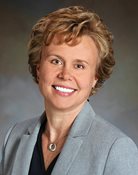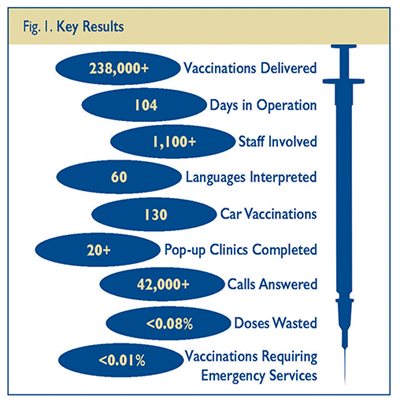Winter 2022 - Vol. 17, No. 3
SCIENTIFIC REPORT
Shots in Arms
Lessons Learned from a COVID-19 Mass Vaccination Site


DeWald Wiborg
Carla DeWald, PT, MBA
Senior Director of Hospital Operations
Penn Medicine Lancaster General Health
Susanna Wiborg, RN, MBA
Chief of Staff
Iron Health
When it became clear in late 2020 that a COVID-19 vaccine would be ready for distribution, the federal government and local institutions across the country began planning for mass vaccination centers. Galvanized by the charge to get “shots in arms” in Lancaster County and the surrounding area, a public-private partnership formed to create the Vaccinate Lancaster Community Vaccine Center.
The partnership, sponsored by a federal grant via the county commissioners, brought together a team of health care, entertainment, safety, and logistics experts. Together, this team delivered more than 238,000 doses over the course of 104 days. This article outlines the critical components that helped to achieve these results.
THE TEAM AND ITS WORK
Health systems from across the area came together, with one — Penn Medicine Lancaster General Health — assuming leadership, along with Rock Lititz, a local company with expertise in the live event industry, and Tri-Starr, a local staffing agency. The diversity in backgrounds across the leadership team, along with the desire to help mitigate and potentially end the impact of the global pandemic in their respective industries, proved to be highly effective in creating an aligned and agile operating team.
This team worked quickly to create the infrastructure necessary to launch a community vaccination center. The local mall’s property management group, Brookfield Properties, donated a 10,000-square-foot vacant department store to serve as the base of the operation.
Prior to the center’s opening, operational leaders met to establish and record workflows by developing a mockup of the site. To maximize flow and capacity, they created a unique vaccine delivery model where patients remained in their chair for the entire experience, including the required 15-minute observation period.
Patient chairs were grouped into units of five, called “cells.” Each vaccinator was assigned a cell. In a 10-hour day, one vaccinator could administer 150 shots, spending up to four minutes with each patient. Cells were then grouped to create a pod, supported by a greeter and an additional staff member to ensure patients were ready for vaccination. In total, the center could support 12 pods or up to 6,600 patients each day.
Vaccine preparation, which included reconstitution and drawing up individual doses, was completed onsite using an hourly batching process. Initially, the medical team administered vaccines by appointment only, allowing them to hone production using data analytics to predict vaccine volume and minimize waste. They also implemented and improved upon a complex end-of-day reconciliation process in an effort to use all drawn doses by day’s end. To ensure minimal waste, patients with future appointments were called and asked to be on a daily standby list. As all associated processes improved, walk-ins were accepted to further improve access.
Other initiatives to improve access included the availability of a community website and call center, an on-demand interpreter service on a mobile cart, and staff to provide wheelchairs and serve as guides for those with mobility needs. Privacy areas were available for those with medical, religious, or cultural concerns that precluded them from being vaccinated in a public setting. Over time, Vaccinate Lancaster offered car vaccinations for those unable to safely enter the facility and designated a private space to vaccinate in a supine position those at risk of syncopal episodes.
The center further supported pop-up clinics in the community by offering staffing and supplies. When vaccine eligibility was expanded to include children 12 years of age and older, center staff modified a pod to allow parents and legal guardians to accompany the minors. Staff also modified pods into a family area to support groups of three or more, while offering activities to serve as distractions.
Visual management proved to be critical to ensuring safety and efficiency, particularly with multiple vaccine manufacturers (i.e., Johnson & Johnson’s Janssen, Pfizer-BioNTech, and Moderna) and dose series onsite. Upon entering, individuals were registered and provided a color-coded sticker and documentation. Color-coding ensured that individuals followed the correct path, landed in the correct queue, and ultimately settled into the correct chair to receive the appropriate vaccine. Minors were identified with badges to ensure consent was obtained and proper techniques followed.
Production and delivery of vaccines were color-coded and kept geographically separate to minimize any risk associated with movement of vaccine. Staff aiding in emergency situations, such as vaccination adverse events, wore high-visibility vests to make them easily identifiable. The presence of local constables throughout the center provided a visual cue to both staff and community members that safety was a top priority.
IMPROVING OPERATIONS
Communication in such a fast-paced operation was of utmost importance. Key leaders and personnel carried radios to allow real-time communication. Staff huddles were held twice daily for each functional team (logistics, registration, clinical, supply, pharmacy), followed by leader huddles to ensure the flow of information. Lean management principles were applied to bring ideas or concerns forward, solidify standard processes, share key metrics, and encourage performance improvement in the form of rapid cycle experiments. Care was taken to limit experiments to two per day to avoid overwhelming the staff and operation.
When appointment volume ramped up, staffing was a critical component in the ability to turn cells and pods “on” or “off.” Given the hours of operation (10 hours, 7 days/week), initial staffing projections proved to be inadequate, particularly for vaccinators. Leaders brought in additional staffing resources, such as the National Guard and a nursing agency, in an expedited fashion. Leaders also developed a streamlined orientation process to ensure staff were properly and quickly trained. An easy-to-use online staffing software tool was used to schedule and communicate with staff.
As demand began to wane, efforts shifted to creating warm hand-offs for both patients and staff. The call center followed up with patients who had outstanding second dose appointments to encourage patients to complete their series prior to closing. Additionally, a process was created and staffed to schedule second dose appointments at partner health systems. For staff seeking employment opportunities, those in good standing were invited to a job fair where all partnership entities were present.
While the center proved highly effective at delivering a high volume of vaccinations efficiently (see Fig. 1), leaders recognized opportunities for improvement along the way. Patients reported having an excellent experience once they were present at the center, however the process to register for an appointment was challenging.

In the initial phases of vaccination, demand far exceeded the guaranteed supply delivery to the center. During this time, patients could register online, but were not guaranteed an appointment unless randomly selected via a digital lottery. As a result, individuals who were technically savvy created multiple registrations, giving them an unfair advantage.
CONCLUSION
Ultimately, the collaboration and work by many helped to save countless lives. Creating a unique and precise operational model — and evolving that model to meet the needs of various community constituents — proved to be successful in meeting the center’s objectives in a short amount of time. The center had the potential to provide far greater than the number of vaccines administered, leading to further need to study engagement opportunities across a diverse community.